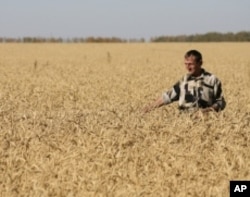2010 ends with food prices on the rise in many parts of the world and reserve supplies tight. That has some experts nervous that another shock could return food prices to levels that triggered violence in 2008.
Riots
In 2008, riots broke out in at least a dozen countries as food prices hit record highs. By 2010, prices had come down as good weather brought bigger harvests. But this February, UN Food and Agriculture Organization chief Jacques
Diouf said the danger was not over.
"All the other factors that led to the price crisis are all here,” he said. “They have not changed."
Diouf said biofuels still compete for food crops. One third of U.S. maize went to ethanol this year.
Energy prices
Energy prices remain high, which also affects the cost of food. And the world population keeps growing. He said that did not bode well for future food security.
"So, if we have - and I pray we don't have it - serious problems of flood and drought in major exporting countries, we're back to square one," said Diouf.
Drought
And in fact, drought in the Black Sea region cut Russia's wheat harvest by a third this year.
Moscow banned wheat exports, which scared the grain markets and made the situation worse.
"It is the drought that triggered the Russian ban,” says Shenggen Fan, head of the International Food Policy Research Institute. “And it's the Russian ban that triggered the price increase."
Prices vary from region to region, but on the global commodity markets wheat and maize have increased almost 50 percent over last year. And experts predict even higher prices next year.
Higher prices
Prices have not returned to where they were two years ago largely because grain stocks were bigger this year than in 2008. But that is no guarantee for coming years.
"I think we really need to take some urgent actions,” Fan says. “If we don't, I guarantee you we will have another crisis."
He believes countries need to invest in making their farmers more productive, because in the long run the world will need to feed more hungry people with less available land, water and other resources, and under a changing climate.
In the short run, markets are nervously watching dry weather in South America. Bad harvests there could push prices up further. And a return to 2008's high prices is not inevitable.
"Certainly we're closer than we are comfortable with right now,” says economist John Anderson with the American Farm Bureau Federation, “but I think it's a little premature to say we're definitely due for a repeat of that magnitude."
Farmers have responded to high prices by planting more, which, barring more weather catastrophes, should eventually bring prices down.
According to Anderson, this is not the first time farmers have faced this challenge.
"We've had growing population and limited resources for the last 10,000 years. And we've managed to deal with that through innovation and improvement in our technology."
But Anderson says it will take time before those improvements impact market prices. In the meantime, he expects food prices to rise at least a little over the next several months.













